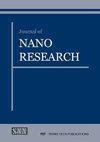Effect of ZnO Nanoparticles Salt Precursors on Structural, Morphological, Optical and MB Photocatalytic Properties Using Hydrothermal Synthesis
IF 1
4区 材料科学
Q4 MATERIALS SCIENCE, MULTIDISCIPLINARY
引用次数: 1
Abstract
ZnO nanoparticles were successfully produced via a simple low cost hydrothermal method using different metal precursors. Zn (CH3COO)2), (Zn (NO3)2) and (ZnCl2) were the source materials. The obtained nanoparticles were investigated by means XRD, SEM and DRS. The XRD exhibited the high crystallinity of the pure ZnO phase with hexagonal wurtzite crystalline structure for all simples excepted for ZnO synthetized from ZnCl2 precursor. The crystallite sizes was estimated in the range of 20-37 nm. The precursor type do not affect the Eg of the nanoparticles. The bandgaps energies were between 3.21-3.22 eV. The type of precursor affect the particles morphology. SEM images revealed different morphologies. The photocatalytic activity of the synthetized ZnO NPs in comparison with that of commercial powder for the methylene blue (MB) degradation under UV irradiation, showed the appropriate activity of nanostructures obtained by Zn (NO3)2 and Zn (CH3COO)2 precursors. The first-order kinetic constant over ZnO from Zn (NO3)2 was 1.9, 3.7 and 1.5 times of ZnO commercial powder, ZnO from ZnCl2 and Zn (CH3COO)2, respectively. The ZnO NPs from Zn (NO3)2 and Zn (CH3COO)2 precursors have the best photocatalytic degradation performance with a degradation rate of 99.3% and 96.4%, respectively. The higher photocatalytic performance was probably due to the larger crystallinity, purity phase and specific morphologies than smaller particle size effect. Thus, the synthetized ZnO nanoparticles by the soft hydrothermal process are a promising candidate for the photocatalytic purposes of dyes from waters.水热合成ZnO纳米盐前驱体对结构、形态、光学和MB光催化性能的影响
采用不同的金属前驱体,通过简单、低成本的水热法制备了氧化锌纳米颗粒。Zn (CH3COO)2)、Zn (NO3)2和ZnCl2为源物质。采用XRD、SEM和DRS对所制得的纳米颗粒进行了表征。XRD结果表明,除由ZnCl2前驱物合成的ZnO外,其余样品均为高结晶度的纯ZnO,具有六方纤锌矿结构。晶体尺寸在20 ~ 37 nm之间。前驱体类型不影响纳米颗粒的Eg。带隙能量在3.21 ~ 3.22 eV之间。前驱体的类型影响颗粒形态。扫描电镜图像显示不同的形态。合成的ZnO纳米粒子在紫外光下降解亚甲基蓝(MB)的光催化活性与商业粉末的光催化活性比较,表明以Zn (NO3)2和Zn (CH3COO)2为前驱物制备的纳米结构具有适当的光催化活性。Zn (NO3)2制得的氧化锌的一级动力学常数分别是工业氧化锌粉、ZnCl2制得的氧化锌和Zn (CH3COO)2制得的氧化锌的1.9倍、3.7倍和1.5倍。由Zn (NO3)2和Zn (CH3COO)2前驱体制备的ZnO NPs光催化降解性能最好,降解率分别为99.3%和96.4%。较高的光催化性能可能是由于更大的结晶度、纯度相和特定的形貌而不是较小的粒径效应。因此,软水热法制备的ZnO纳米颗粒是光催化水中染料的理想材料。
本文章由计算机程序翻译,如有差异,请以英文原文为准。
求助全文
约1分钟内获得全文
求助全文
来源期刊

Journal of Nano Research
工程技术-材料科学:综合
CiteScore
2.40
自引率
5.90%
发文量
55
审稿时长
4 months
期刊介绍:
"Journal of Nano Research" (JNanoR) is a multidisciplinary journal, which publishes high quality scientific and engineering papers on all aspects of research in the area of nanoscience and nanotechnologies and wide practical application of achieved results.
"Journal of Nano Research" is one of the largest periodicals in the field of nanoscience and nanotechnologies. All papers are peer-reviewed and edited.
Authors retain the right to publish an extended and significantly updated version in another periodical.
 求助内容:
求助内容: 应助结果提醒方式:
应助结果提醒方式:


